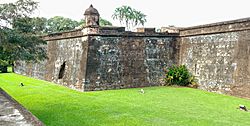Fortaleza de San Fernando facts for kids
Quick facts for kids Fortaleza de San Fernando |
|
|---|---|
| Omoa, Honduras | |

Fortaleza de San Fernando
|
|
| Lua error in Module:Location_map at line 420: attempt to index field 'wikibase' (a nil value). | |
| Type | Fortress |
| Site information | |
| Owner | Honduras |
| Controlled by | Honduras |
| Open to the public |
Yes |
| Condition | Preserved |
| Site history | |
| Built | 1756 |
| In use | 1775–present |
| Materials | Brick, river rocks, coral |
| Battles/wars | Battle of San Fernando de Omoa (1779) |
The Fortaleza de San Fernando (also called the Castillo de San Fernando de Omoa) is an old Spanish fortress in Omoa, Honduras. It was built a long time ago, between 1756 and 1775. This strong fort helped protect Spanish lands and interests in a region then known as the Captaincy General of Guatemala. Later, in 1821, the government of Honduras took control of it. Today, the fortress is still mostly in good shape and is a popular place for tourists to visit in Omoa.
Contents
A Look at the Fortress's Past
How the Spanish Built Defenses
After the Spanish took control of Guatemala, their large empire started building forts to protect their new areas. As part of this plan, the Spanish built a small fort near the bay of Omoa. This bay was a very important natural harbor. For many centuries, Spain kept building and improving defenses in Omoa. There was a native village in the area when the first fort was built. But soon, its people were moved away and made to work under a system called Repartimiento.
Protecting Trade Routes from Pirates
By the late 1500s, pirates became a big problem for the Spanish in the New World. To keep their valuable silver trade safe, Spain made the fort at Omoa even stronger. The bay became a main port where silver was sent from Central America to Spain. In 1609, Omoa became part of the area managed by the Captaincy General of Guatemala.
Building the Great Fortress
In the 1700s, the Spanish Empire decided that Omoa Bay was a good spot for a new town. So, they started a new port town there, which is now the modern town of Omoa. To protect this new port, they planned to build a much bigger fortress next to the smaller one. This larger fort was named the Fortaleza de San Fernando. It was built between the mid-1700s (some say 1756, others 1759 or 1768) and 1775. The fortress was made from strong brick and coral.
The Fortress in Battle
The fort was first tested in 1779. At that time, Spain joined France and the new United States in the American Revolutionary War. Spain wanted to fight against its old rival, Britain. Because Spain joined the war, the British started attacking Spanish colonies in Central America, including parts of the Captaincy of Guatemala.
In October 1779, a small group of British ships attacked the fortress. They captured it. But the Spanish fought back a few weeks later. They eventually made the British leave.
Changes in Control Over Time
By the 1820s, Spain's power over its Central American colonies was much weaker. Many former colonies were gaining independence. The Fortaleza de San Fernando was one of the last Spanish strongholds to be taken. The First Mexican Empire captured the fortress in 1821.
Control of the fort then went to the Federal Republic of Central America when it separated from the Mexican Empire in 1823. When Honduras left the federation in 1838, the fortress came under the control of the Honduran government. They used it as a prison for some time.
In 1959, the fortress was officially named a national monument. Today, it is a popular place for tourists to visit and learn about history.
The Fortress Museum
The fortress of San Fernando de Omoa was declared a National Historic Center on May 11, 1959. It is a great example of Spanish rule in Honduras during the colonial period. It also has huge historical importance because it is the largest military fortress built in Central America.
Next to the fortress, there is a museum. This museum has important historical items about the fortress. You can see a model of the fort, old armor, and weapons from that time.
Gallery
See also
 In Spanish: Fortaleza de San Fernando para niños
In Spanish: Fortaleza de San Fernando para niños
- Santa Bárbara Fortress
- San Cristóbal Fortress
- History of Honduras








